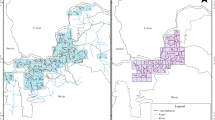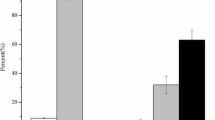Abstract
Background, aim, and scope
Foraging patches can be described as a nested hierarchy of aggregated resources, implying that study of foraging by wild animals should be directed across different spatial scales. However, almost all previous research on habitat selection by the giant panda has concentrated upon one scale. In this research, we carried out a field study to understand foraging patch selection by giant pandas in winter at both microhabitat and feeding site scales and, for the first time, attempted to understand how long it would stay at the feeding sites before moving on.
Materials and methods
The field survey was conducted from November 2002 to March 2003 at Fengtongzhai Nature Reserve (102°48′–103°00′ E, 30°19′–30°47′ N), Baoxing County of Sichuan Province, China, to collect data in both microhabitat and control plots. The microhabitat plots were located by fresh feces or foraging traces left by giant pandas, and the control plots were established to reflect the environment. Within each microhabitat plot, one 1 × 1 m2 plot was centralized at the center of each feeding site, in which numbers of old bamboos and old shoots, including eaten and uneaten, were counted, respectively.
Results
The results showed that winter microhabitats selected by this species were characteristic of gentle slopes and high old-shoot proportions and that the latter was even higher at feeding sites. Two selection processes, namely, from the environment to microhabitats and from the latter to feeding sites, were found during this species’ foraging patch utilization. Giant pandas preferred to eat old shoots to old bamboo at feeding sites in winter and did not leave unless old-shoot density fell to lower than the average in the environment.
Discussion
Both microhabitats and feeding sites selected by giant pandas were characteristic of high old-shoot density, indicating that the preferred food item had a significant influence upon its foraging patch selection. The preference for gentle slopes by giant pandas was presumed to save energy in movement or reflect the need to sit and free its fore-limbs to grasp bamboo culms when feeding but also seemed to be correlated with an easier access to old shoots. The utilization of old shoots at feeding sites was assumed to help maximize energy or nutrient intake during their foraging.
Conclusions
The difference between microhabitat plots and control plots and between microhabitats and feeding sites uncovered a continuous selection process from the environment via microhabitats to feeding sites. The utilization of old shoots at feeding sites was parallel to the marginal value theorem. The selection and abandonment of foraging patches by giant pandas was an optimal behavioral strategy adapted to their peculiar food with high cellulose and low protein.
Recommendations and perspectives
Our results uncovered the importance of multiple scales in habitat selection research. To further understand the process of habitat selection, future research should pay more attention to resolve the question of how to locate foraging patches under dense bamboo forests by the giant panda, which was traditionally considered to have poor eyesight, although our research has answered what type of habitats the giant panda prefers and when to leave.


Similar content being viewed by others
References
Andrea LL, Gaines WL, Servheen C (2003) Black bear resource selection in the northeast Cascades, Washington. Biol Conserv 113:55–62
Bailey DW, Gross JE, Laca EA, Rittenhouse LR, Coughenour MB, Swift DM, Sims PL (1996) Mechanisms that result in large herbivore grazing distribution patterns. J Range Manage 49:386–400
Brown JS (1988) Patch use as an indicator of habitat preference, predation risk, and competition. Behav Ecol Sociobiol 22:37–47
Charnov EL (1976) Optimal foraging, the marginal value theorem. Theo Pop Biol 9:129–136
Cook CW (1966) Factors affecting utilization of mountain slopes by cattle. J Range Manage 19:200–204
Daniel R, Coulson G (2002) Density dependence in foraging preference of eastern grey kangaroos. Oikos 98:393–402
Dave PO, Heric CH, Mitchell FS, Skiles JR (2003) Home range and habitat use of American black bears on a desert montane island in Texas. Ursus 14:120–129
Eloy R, Francisco P, Miguel D (2000) Defining key habitats for low density populations of Eurasian badgers in Mediterranean environments. Biol Conserv 95:269–277
Fabrizio S, Pedrini P, Marchesi L (2003) Adaptive selection of foraging and nesting habitats by black kites (Milvus migrants) and its implications for conservation: a multi-scale approach. Biol Conserv 112:351–362
Gordon HO, Wittenberger JF (1991) Spatial and temporal scales in habitat selection. Am Nat 137:29–49
Hemani MR, Watkinson AR, Dolman PM (2004) Habitat selection by sympatric muntjac (Muntiacus reevesi) and roe deer (Capreolus capreolus) in a lowland commercial pine forest. Forest Ecol Manage 194:49–60
Hu JC, Schaller GB, Pan WS, Zhu J (1985) The giant panda of Wolong. Sichuan Science and Technology Press, Chengdu, China
Johnson DH (1980) The comparison of usage and availability measurements for evaluating resource preference. Ecology 61:65–71
Kate RS, Hobbs NT, Shipley LA (2005) Should I stay or should I go? Patch departure decisions by herbivores at multiple scales. Oikos 111:417–424
Kotliar NB, Wiens JA (1990) Multiple scales of patchiness and patch structure—a hierarchical framework for the study of heterogeneity. Oikos 59:253–260
Liang QW, Thomson AJ (1994) Habitat–abundance relationships of the earthworm Eisenia rosea (Savigny) (Lumbricidae), using principle component regression analysis. Can J Zool 72:1354–1361
Lindburg DG, Baragona K (2004) Giant pandas: biology and conservation. University of California Press, Berkeley, California
Morris DW (1987) Ecological scale and habitat use. Ecology 68:362–369
Morris DW (1992) Scales and costs of habitat selection in heterogeneous landscape. Evol Ecol 6:412–432
Morris DW, Douglas LD (2000) Optimally foraging mice match patch use with habitat differences in fitness. Ecology 81:2061–2066
Mueggler FW (1965) Cattle distribution on steep slopes. J Range Manage 18:255–257
O’Neill RV, Deangelis DL, Waide JB, Allen TFH (1986) A hierarchical concept of ecosystems. Princeton University Press, New Jersey
Reid DG, Hu JC (1991) Giant panda selection between Bashania faberi habitats in Wolong Nature Reserve, Sichuan, China. J Appl Ecol 28:228–243
Schaefer KR, Messier F (1995) Winter foraging by muskoxen: a hierarchical approach to patch residence time and cratering behavior. Oikos 104:39–44
Sebastien S, Perrin N, Neet C (2003) Winter habitat selection by two sympatric forest grouse in Western Switzerland: implications for conservation. Biol Conserv 112:373–382
Senft RL, Coughenour MB, Bailey DW, Rittenhouse LR, Sala OE, Swift DM (1987) Large herbivore foraging and ecological hierarchies. Bioscience 37:789–799
Sih A (1980) Optimal foraging: partial consumption of prey. Am Nat 116:281–290
Wei FW, Zhou A, Hu JC, Wang W, Yang G (1996a) Habitat selection by the giant panda in Mabian Dafengding Nature Reserve. Acta Theriol Sinica 16:241–245
Wei FW, Zhou CQ, Hu JC, Yang G, Wang W (1996b) Bamboo resource selection and utilization by the giant panda in Mabian Dafengding Nature Reserve. Acta Theriol Sinica 16:171–175
Wei FW, Feng Z, Wang Z, Li M (1999) Feeding strategy and resource partitioning between giant and red pandas. Mammalia 63:417–430
Wei FW, Wang ZW, Hu JC (2000) Habitat use and separation between the giant panda and the red panda. J Mammal 80:448–455
Wiens JA (1976) Population response to patchy environments. Ann Rev Ecol System 7:81–120
Zhang ZJ, Wei FW, Li M, Zhang BW, Liu XH, Hu JC (2004) Microhabitat separation during winter among sympatric giant pandas, red pandas and tufted deer: the effects of diet, body size, and energy metabolism. Can J Zool 82:1451–1458
Zhang ZJ, Wei FW, Li M, Hu JC (2006) Winter microhabitat separation between giant and red pandas in Bashania faberi bamboo forest in Fengtongzhai Nature Reserve. J Wildlife Manage 70:231–235
Acknowledgments
This research was supported by the National Basic Research Program of China (973 Program, 2007CB411600), National Natural Science Foundation of China (30370203, 30670305), CAS Innovative Research International Partnership Project (CXTDS 2005-4), CAS 100 Talent Programme and Sichuan Provincial Science and Technology Fund for Distinguished Scholars (07ZQ026-017). Ms. Baowei Zhang, Jiandong Yang, Zongxian Han, Minghua Wang, Xianlin Zhang, Min Gao, Yuhui Luo and Guiren Li participated in the fieldwork. The Sichuan Forestry Bureau and Fengtongzhai Nature Reserve Administration Bureau provided us with a great deal of assistance for the project.
Author information
Authors and Affiliations
Corresponding author
Additional information
Responsible editor: Ding Wang
Rights and permissions
About this article
Cite this article
Zhang, Z., Zhan, X., Yan, L. et al. What determines selection and abandonment of a foraging patch by wild giant pandas (Ailuropoda melanoleuca) in winter?. Environ Sci Pollut Res 16, 79–84 (2009). https://doi.org/10.1007/s11356-008-0066-4
Received:
Accepted:
Published:
Issue Date:
DOI: https://doi.org/10.1007/s11356-008-0066-4




